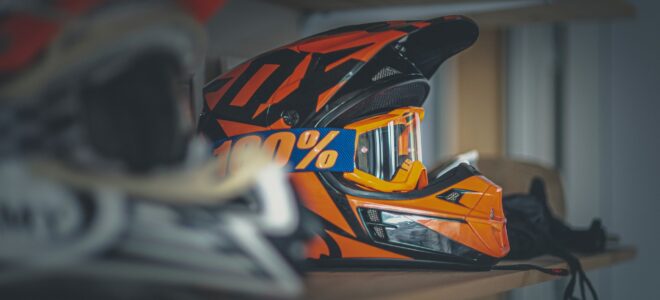
When it comes to motocross, there are endless amounts of different gear and equipment that you need in order to be safe and successful while riding. One of the most important pieces of gear that you need is a helmet. There are many different types of motocross helmets on the market, and it can be difficult to decide which one is right for you. In this blog post, we will explore 3 different types of motocross helmets and provide tips for choosing the right one for you.
Motocross Helmets
There are a few motocross helmets out there to choose from. Here are the different types of motocross helmets and some tips on how to choose the right one for you.
– Full face helmets: Full face helmets offer the most protection for your head and face. They have a chin bar that protects your chin and jaw, and a visor that protects your eyes from debris. Full face helmets are the safest choice for racing and riding in rough terrain.
– Modular helmets: Modular helmets have a flip-up visor that allows you to easily transition from riding with an open face to riding with a full face helmet. They offer less protection than full face helmets, but more than half shell helmets.
– Half shell helmets: Half shell helmets only cover the top half of your head and do not have a visor or chin bar. They are the least protective option, but they are also the lightest and most comfortable option.
Full-Face Helmets

Source: pinterest.com
Full-face helmets are the safest type of motocross helmet and offer the most protection for your head, neck and face. They are required in most racing organizations and are strongly recommended for all off-road riding. Full-face helmets have a solid shell that covers your entire head and a visor that protects your eyes from flying debris. They typically have more ventilation than other types of motocross helmets to keep you cool and comfortable while riding.
When choosing a full-face helmet, it is important to select one that fits properly. The helmet should be snug but not too tight, and it should sit low on your forehead with the eye port level with your eyebrows. The chin strap should be fastened securely, but not too tightly, so that you can easily open your mouth to breathe. You should also check to make sure that the helmet’s visor does not obstruct your vision in any way.
If you plan on doing any night riding, be sure to choose a full-face helmet that has been approved for use with night vision goggles. And if you wear prescription glasses, look for a helmet with an adjustable or removable visor so that you can still see clearly while riding.
Open-Face Helmets

Assuming you are looking for a more in-depth look at open-face helmets, here are some things to consider before making your purchase.
Open-face helmets provide less coverage than full-face helmets, but many riders find them more comfortable. They can be especially beneficial for those who wear glasses or sunglasses, as they make it easier to put on and take off your helmet without having to remove your glasses first.
There are a few downsides to open-face helmets, however. They offer less protection for your face in the event of an accident, and they can be noisier than full-face helmets since there’s nothing covering your ears.
When choosing an open-face helmet, it’s important to pay attention to the fit. The helmet should sit snugly on your head without being too tight. You also want to make sure that the visor is big enough to give you a clear view while riding.
If you’re looking for maximum protection, a full-face helmet is the way to go. But if you prefer the feeling of wind in your face and want a lighter, more comfortable option, then an open-face helmet is a great choice.
Dual-Sport Helmets

Dual-sport helmets are designed for both on and off-road riding, and offer the best of both worlds in terms of protection and comfort. They typically have a visor to protect your eyes from the sun and debris, as well as a full-face design to protect your head in the event of a crash.
When choosing a dual-sport helmet, it’s important to find one that fits snugly and is comfortable to wear for long periods of time. You should also make sure that the helmet has adequate ventilation to keep you cool in hot weather.
Tips for Choosing a Motocross Helmet
When it comes to choosing a motocross helmet, there are a few things you need to take into account in order to make sure you’re getting the best possible option for your needs. Here are a few tips to help you choose the right motocross helmet:
- Make sure the helmet you’re considering is DOT (Department of Transportation) approved. This means that it meets or exceeds all safety standards set by the DOT, and is therefore safe for use on public roads and tracks.
- Consider the weight of the helmet. A heavier helmet may be more protective, but it can also be more difficult to wear for long periods of time. If you plan on doing a lot of racing or riding, choose a lighter helmet that won’t weigh you down.
- Ventilation is important in a motocross helmet, as you’ll be working up a sweat while riding. Make sure the helmet you choose has plenty of vents to keep you cool and comfortable while riding.
- The fit of the helmet is also important. It should fit snugly but not too tight, and should stay in place even when you’re moving around a lot. Try on helmets at different stores before making your final decision to make sure you’re choosing one that’s comfortable for you.
- Price is always a consideration when purchasing any type of gear, but don’t sacrifice safety for cost when it comes to your motocross helmet . Choose a helmet that’s within your budget but that also offers the features and protection you need.
Conclusion
When it comes to choosing the right motocross helmet, there are a few things you need to take into consideration. With so many different types of helmets on the market, it can be difficult to decide which one is right for you. However, if you keep in mind the tips we’ve outlined in this article, you should be able to find a helmet that will offer you the protection you need while out on the track. Thanks for reading and we hope this has helped you in your search for the perfect motocross helmet!



